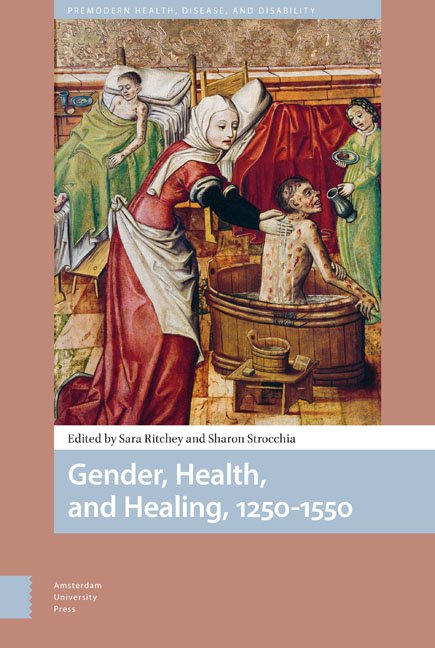Book contents
- Frontmatter
- Contents
- List of Figures and Tables
- Acknowledgments
- Abbreviations
- Introduction: Gendering Medieval Health and Healing: New Sources, New Perspectives
- Part 1 Sources of Religious Healing
- 1 Caring by the Hours: The Psalter as a Gendered Healthcare Technology
- 2 Female Saints as Agents of Female Healing: Gendered Practices and Patronage in the Cult of St. Cunigunde
- Part 2 Producing and Transmitting Medical Knowledge
- 3 Blood, Milk, and Breastbleeding: The Humoral Economy of Women's Bodies in Medieval Medicine
- 4 Care of the Breast in the Late Middle Ages: The Tractatus de passionibus mamillarum
- 5 Household Medicine for a Renaissance Court: Caterina Sforza's Ricettario Reconsidered
- 6 Understanding/Controlling the Female Body in Ten Recipes: Print and the Dissemination of Medical Knowledge about Women in the Early Sixteenth Century
- Part 3 Infirmity and Care
- 7 Ubi non est mulier, ingemiscit egens?: Gendered Perceptions of Care from the Thirteenth to Sixteenth Centuries
- 8 Domestic Care in the Sixteenth Century: Expectations, Experiences, and Practices from a Gendered Perspective
- 9 Bathtubs as a Healing Approach in Fifteenth-Century Ottoman Medicine
- Part 4 (In)fertility and Reproduction
- 10 Gender, Old Age, and the Infertile Body in Medieval Medicine
- 11 Gender Segregation and the Possibility of Arabo-Galenic Gynecological Practice in the Medieval Islamic World
- Afterword: Healing Women and Women Healers
- Contributors
- Index
2 - Female Saints as Agents of Female Healing: Gendered Practices and Patronage in the Cult of St. Cunigunde
Published online by Cambridge University Press: 23 June 2021
- Frontmatter
- Contents
- List of Figures and Tables
- Acknowledgments
- Abbreviations
- Introduction: Gendering Medieval Health and Healing: New Sources, New Perspectives
- Part 1 Sources of Religious Healing
- 1 Caring by the Hours: The Psalter as a Gendered Healthcare Technology
- 2 Female Saints as Agents of Female Healing: Gendered Practices and Patronage in the Cult of St. Cunigunde
- Part 2 Producing and Transmitting Medical Knowledge
- 3 Blood, Milk, and Breastbleeding: The Humoral Economy of Women's Bodies in Medieval Medicine
- 4 Care of the Breast in the Late Middle Ages: The Tractatus de passionibus mamillarum
- 5 Household Medicine for a Renaissance Court: Caterina Sforza's Ricettario Reconsidered
- 6 Understanding/Controlling the Female Body in Ten Recipes: Print and the Dissemination of Medical Knowledge about Women in the Early Sixteenth Century
- Part 3 Infirmity and Care
- 7 Ubi non est mulier, ingemiscit egens?: Gendered Perceptions of Care from the Thirteenth to Sixteenth Centuries
- 8 Domestic Care in the Sixteenth Century: Expectations, Experiences, and Practices from a Gendered Perspective
- 9 Bathtubs as a Healing Approach in Fifteenth-Century Ottoman Medicine
- Part 4 (In)fertility and Reproduction
- 10 Gender, Old Age, and the Infertile Body in Medieval Medicine
- 11 Gender Segregation and the Possibility of Arabo-Galenic Gynecological Practice in the Medieval Islamic World
- Afterword: Healing Women and Women Healers
- Contributors
- Index
Summary
Abstract
This essay studies the mechanics informing the construction of a single healing cult, that of the virgin saint Empress Cunigunde (c.980-1033) and its gender aspects. The shrine of St. Cunigunde in Bamberg was well known as a healing space after her canonization in 1200, although the first miracle collection does not reveal any medical specialization of the cult. Using previously neglected late medieval narrative and archival material, the essay shows that Cunigunde was a popular female patron whose assistance was sought by women, especially during childbirth. This case of female medical patronage is analysed alongside similar practices in the cults of other saints and is regarded as one of the resources for female convalescence in the medical market of that time.
Keywords: miraculous healing, healing relics, Bamberg, holy virgins, female health
One of the most common medical practices available in the Middle Ages was miraculous healing performed through the intercession of saints. Cults of saints created and successfully maintained a powerful economy of miraculous aid throughout the medieval period and beyond. This economy rested on a profound belief in the efficacy of saints’ powers, accessed by a devotee through an invocation or contact with a relic, which attracted immense financial and human resources to veneration sites. While some cults achieved a European-wide reputation, most saints exercised their powers within local communities and were invoked to remedy specific maladies. This medical specialization among saints, most evident in the late Middle Ages, was ridiculed by contemporaries, as when Erasmus of Rotterdam parodied, ‘Each saint has his distinct office allotted to him, and is accordingly addressed to upon the respective occasions: as one for the tooth-ache, a second to grant an easy delivery in child-birth, a third to help persons [find] lost goods, another to protect seamen in a long voyage, a fifth to guard the farmer's cows and sheep, and so on; for to rehearse all instances would be extremely tedious’. As Erasmus's comments suggest, miraculous interventions functioned as an important resource for healing and relief, including relief in matters of gynecology and obstetrics. However, the role of saints and of God's therapy has not yet been fully incorporated into our understanding of medieval medical practice.
- Type
- Chapter
- Information
- Gender, Health, and Healing, 1250–1550 , pp. 67 - 90Publisher: Amsterdam University PressPrint publication year: 2020



